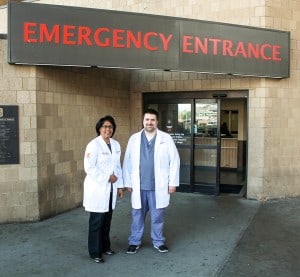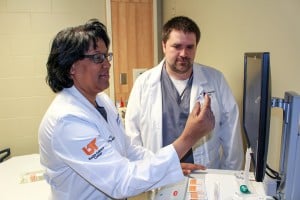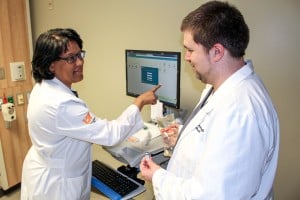When a public health crisis emerges, it’s the emergency room physicians of American’s major urban hospitals who find themselves on the frontline. How they react can be crucial to saving lives and addressing the problem.
That challenging work is underway at Regional One Health with the Opioid Light program after emergency medicine physician Chantay Smartt, MD started noticing an alarming trend in 2016.

Chantay Smartt, MD and Justin Griner, PharmD are spearheading Opioid Light at Regional One Health, encouraging providers to prescribe fewer opioids whenever possible.
One after another, patients arrived in respiratory distress after overdosing on opioids. Some came in awake, having been given a dose of the reversal drug Narcan by paramedics. Others were dropped on the curb, unconscious and not breathing, by whoever they’d been using with.
It mirrors a trend statewide, where opioid-related deaths have been rising for six or seven years. In 2017, 1,776 Tennesseans lost their lives.
“We asked ourselves, ‘What can we do to help our community?’” Dr. Smartt said. “We decided to look at whether our doctors were prescribing too many opioids and what we could recommend as alternatives. The idea is that by keeping patients who didn’t need opioids from being exposed to them, we could help our community best.”
“When somebody is addicted to an opioid, it’s a major undertaking to detox and go through rehab. It’s not something we can do in the emergency department,” said Justin Griner, PharmD, Regional One Health emergency department pharmacist.
“But what we could do is move away from opioids as the first line when appropriate. When there is a non-addictive alternative, we use that instead.”
That idea formed the basis for the Opioid Light pilot program at Regional One Health. Dr. Smartt and Griner created a dashboard that prompts providers to consider opioid alternatives and to evaluate pain more often in hopes of discontinuing opioids sooner.

“Doctors have to look at the patient and ask, ‘How many days will they be in acute pain? How many pills do they really need?’” Dr. Smartt says.
Griner explained why both are so important: “We’re looking at the long game – trying to cut it off at the pass and prevent that cascade into addiction,” he explained.
He noted even a short course of opioids can lead to dependence. The body quickly develops a tolerance, so in months a patient can go from taking a few pills a day to dozens: “Eventually, the amount someone takes when they’re in the throes of addiction is astronomical.”
That’s when many addicts turn to illegal drugs like heroin, which are cheaper and more readily available, Dr. Smartt said. That opens up new problems, as heroin sold on the street may be laced with powerful synthetic drugs like fentanyl, which are often the culprit for overdoses.
Avoiding that spiral altogether is possible for many patients, even in the emergency department. As Griner noted, “An opioid is a very powerful pain reliever. Sometimes very powerful, aggressive pain relief is necessary – but there are a lot of conditions where it isn’t.”
Those include headaches, back pain, abdominal pain and toothaches, which often respond well to Tylenol, Advil, Aleve, Lyrica and combinations of those medicines – or to non-pharmaceutical options like physical therapy, yoga, meditation, art therapy, etc.
Dr. Smartt and Griner encouraged their colleagues at Regional One Health to look to those alternatives first whenever possible, taking into consideration the nature of the pain, side effects, drug interactions, compatibility with patients’ existing medical conditions, etc.
They also addressed situations where opioids are necessary, like severe trauma, burns, fractures, sickle cell disease pain and acute post-operative pain. As Griner noted, the goal is not to under-treat pain, but to treat pain more safely.
“We took our default of prescribing 20 opioid pills and removed it,” Dr. Smartt said. “Doctors have to look at the patient and ask, ‘How many days will they be in acute pain? How many pills do they really need?’” Under Opioid Light, patients get enough opioids to cover the expected acute pain period, then doctors reevaluate them with an eye toward switching to safer options.

By exposing fewer patients to opioids, “We’re looking at the long game – trying to cut it off at the pass and prevent that cascade into addiction,” Griner said.
Opioid Light also includes education. Emergency department personnel can’t require a patient to enter rehab, but can encourage them. Dr. Smartt said overdose patients and their families receive information on treatment options, navigating the system, how to dispose of old prescriptions, etc.
These efforts are paying off. A Tennessee Hospital Association study on opioid use in emergency departments showed Regional One Health reduced its use by 20 percent during 2018.
“Dr. Smartt has led by example in her practice,” Griner said. “She provided another path for doctors to follow, and she made them aware of what we were doing and why we were doing it.”
Dr. Smartt added they’ve had great collaboration via an Opioid Stewardship Committee – staff from anesthesia, orthopedics, sickle cell, outpatient clinics, pharmacy, surgery, trauma, etc. are involved – and the team continues to collect data and find ways to decrease exposure to opioids.
It’s the type of reaction that can rewrite conventional wisdom among providers, improve care for patients, and – as Dr. Smartt first envisioned – help the community in which we live. “In a way, this is a problem the medical community contributed to,” Dr. Smartt said, noting for years opioids were viewed as safe and non-addictive. “It’s up to us to try to fix it.”

